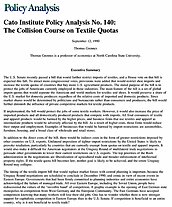The U.S. Senate recently passed a bill that would further restrict imports of textiles, and a House vote on that bill is expected this fall. To attract more congressional votes, provisions were added that would restrict shoe imports and increase the textile quotas of countries that buy more U.S. agricultural products. The stated purpose of the bill is to protect the jobs of Americans currently employed in those industries. The main feature of the bill is a set of global import quotas that would separate the American and world markets for textiles and shoes. It would preserve a share of the U.S. market for domestic producers regardless of the relative costs of imported and domestic products. Since market shares would be determined by politicians and bureaucrats rather than consumers and producers, the bill would further diminish the influence of private competitive markets for textile products.
If implemented, the bill would protect the jobs of some textile workers. However, it would also increase the price of imported products and all domestically produced products that compete with imports. All final consumers of textile and apparel products would be harmed by the higher prices, and business firms that use textiles and apparel as intermediate products would be adversely affected by the bill. As a result of higher costs, those firms would reduce their output and employment. Examples of businesses that would be harmed by import restrictions are automobiles, furniture, housing, and a broad class of wholesale and retail stores.
In addition to the direct costs of the bill, there would be indirect costs in the form of greater restrictions imposed by other countries on U.S. exports. Unilateral imposition of tighter import restrictions by the United States is likely to provoke retaliation, particularly by countries that are currently exempt from quotas on textile and apparel imports. It would also make it difficult for American negotiators at the Uruguay Round of multilateral trade negotiations to persuade other governments to lower their current restrictions on U.S. exports. The top priorities of the Bush administration in the negotiations are liberalization of agricultural trade and broader enforcement of intellectual property rights. If the textile quota bill becomes law, neither goal is likely to be achieved, and the entire Uruguay Round may collapse.
The timing of the textile import bill that would replace market forces with central planning is important, because the Uruguay Round negotiations are scheduled to conclude in December 1990, and ironic in view of recent events in Eastern Europe. Governments that had been firmly committed to planning industries and entire economies have acknowledged the failure of managed trade. All over Eastern Europe, including the Soviet Union, people have rediscovered the virtues of the “invisible hand” of competition. A graphic example is the opening of East German state monopolies to competition from West Germany and the European Community. The East Germans have accepted competition knowing that many workers will lose their old jobs. One has to wonder whether there is now stronger support for capitalistic competition in Eastern Europe than in the U.S. Senate. If competition is beneficial to an entire country, why is it not beneficial to textile trade?
This paper is an analysis of the textile import bill and the case for textile protection in general. Textile trade restrictions already cost American consumers $20.3 billion a year (as of 1986), or $238 annually for every American household.[1] The bill and the continuation of the Multifiber Arrangement (MFA) that governs world textile trade would result in net costs for the United States and the world economy. The world textile industry would be more efficient if market shares were determined by the forces of competition, not political considerations. The industry’s proposal would tighten quotas and extend them indefinitely, but consumer interests would be best served by abolishing quotas immediately. A compromise would be to announce a terminal date for quotas and phase them out gradually.

This work is licensed under a Creative Commons Attribution-NonCommercial-ShareAlike 4.0 International License.
